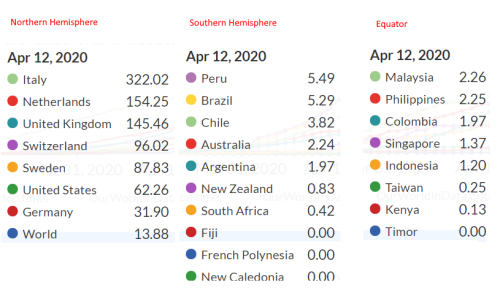We appear to have 7 Australian governments that are paralysed, unable to decide whether they are really "flattening the curve", which means spreading the same number of infections out over a longer period of time, or "obliterating the curve", meaning eliminating the virus altogether. While they are still talking about "flattening the curve" they appear to want to eliminate new infections before they start relaxing restrictions, and that's a confusing message, and a recipe for long term disaster because it envisages a series of lockdowns. Proper flattening of the curve meant only one real lockdown.
That's not the only area where governments seem confused or are getting it wrong.
Primacy of the disease over everything else
The first thing I want to comment on is the primacy that we are giving this disease and what appears to be a radical reshaping of our tolerance of risk. We live and work with diseases that kill some of us, and that we infect each other with, all the time. Generally we don't shut the economy down because of a flu epidemic, although we did a hundred years ago with Spanish Flu, but that is a very rare event.
Advertisement
This pandemic is not the Black Death, which killed somewhere around half of Europe, and probably not even the Spanish Flu, which killed perhaps 1% of the world's population.
The first reports I saw suggested a mortality rate as high as 20% and a rate of transmission as high as 5. That warranted strong interventions. Flattening the curve was a real imperative, but once we got the logistics sorted to enable the overload of cases to be hospitalised, the only viable plan seemed to be to go back to work and take our chances with the disease, as we always have with other diseases. But that's not what we are doing.
How good is Australia's performance?
We appear to have one of the best performances in the world when you look at fatalities. The table below measures the fatalities per million. It gives you some comparisons, but it also should raise some significant questions, like why the death rate is so low in the southern hemisphere.

Source: https://ourworldindata.org/coronavirus
It might be that infections arrived here later, and we learned from others and took better precautions. Maybe, but surely not all those countries in the right hand two columns could be that superior to their northern cousins. Or it might be that it is not our flu season yet, and it is Europe's, or that the virus does not like higher temperatures.
Advertisement
Another thing you can see from this is that Sweden, which has kept open through all of this, is not doing too badly, for a northern hemisphere country. It certainly doesn't have a death rate that deserves the derision it has been receiving.
How dangerous is COVID-19?
If you get it into your lungs, and it triggers an auto-immune reaction, it is very serious, causing pneumonia. Otherwise it appears to be not so serious, and many people get such a mild dose they don't realise they've had it. The flu also causes pneumonia, but has a reproductive rate (the number of person one person will infect) between 0.9 and 2.1 and fatality rate of about 0.1%. COVID-19 has a reproductive rate of somewhere between 1.4 and 5.7 and a fatality rate that the Queensland government puts at 1%, but WHO puts at 3.5%.
You might have noticed that the figures for the flu come with a smaller spread than COVID-19. That's because we still really don't know enough about this disease to be very accurate. So it is no wonder that the various models come to different answers, and in most cases seem to have over-estimated the severity of the outbreak by orders of magnitude. As the latest from Professor John Ioannidis suggests, fatality rates may be nowhere near as high as suggested because the disease is probably more prevalent in the community than we realise.
Discuss in our Forums
See what other readers are saying about this article!
Click here to read & post comments.
87 posts so far.